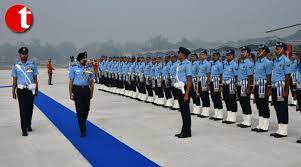Air Marshall Of Air Force (AOC-in-C / VCAS) 2022-23
New DelHI: Air Marshal Sandeep Singh (AVSM VM) took over as Deputy Chief Aviation Officer (VCAS) on Friday. An alumnus of the National Defense Academy, the Air Marshal was given a job at the Indian Air Force (IAF) flying branch in December 1983 as a pilot. The Air Force Officer is Pilot Test Pilot and a trained flight instructor. He has rich and unique experience in performance testing and flying tests on various types of fighter jets and travels about 4,400 hours.

DRDO will show two tableaux during the republic day parade 2022
BRO made the final explosion of all the excavations in the Sela Tunnel Project
Bhanu Prakash Srivastava has been appointed as the next Director (Other Units) of BEL
In almost 38 years of working for the IAF, the Air Marshal has held a number of important mandates and appointments. He has commissioned Aircraft and Systems Testing Establishment, a leading aviation base and an active military team.
He holds the positions of Senior Assistant Air Force (Programs), Chief Air Force Officer at HQ Eastern Air Command and Deputy Chief Air Force personnel at Head Office. Prior to taking over the current position, he held the appointment of AOC-in-C South Western Air Command.
The Air Marshal received the Ati Vishisht Seva Award and the Vishisht Seva Award.

The whole nation is celebrating 89th Air Force Day today. On 8 October 1932, the Indian Air Force (IAF) was officially launched as a ‘Royal Air Force’. In 1950, the Royal Initiative was abolished when India switched to the Republic and became the ‘Indian Air Force’. An organization that started with 6 police officers and 19 Hawai Sepoys back in 1933, the IAF is the fourth largest in the world today.
Over the years, the IAF has produced some air force officers who not only served the nation in full glory but also took India to a higher level.
1) Arjan Singh
Known as the icon of Indian military history, Air Force Marshal Arjan Singh, will always be remembered as a colossus of the IAF for his professionalism, leadership and strategic vision. Arjan Singh is the only official in IAF history to secure the top position of Marshal, the Air Force’s five-star air force.
He played a major role in transforming the IAF into one of the world’s most powerful air forces and successfully led the small IAF during the 1965 Indo-Pak war.

Born 15 April 1919, Arjan Singh in his early days as a student was a beneficiary. As an ace swimmer, he holds the record for the rest of India in freestyle swimming at one and a half mile miles. At the age of 19, he was selected for training at RAF Cranwell in 1938. He is studying higher education among his Indian Cadet team.
With his outstanding leadership, great talent and courage in the Burmese Campaign during World War II. He was awarded the Distinguished Flying Cross (DFC) in 1944.
In 1965 the Indo-Pak war, Air Marshal Arjan Singh as Chief of Air Force, led the IAF in the war against Pakistan, in which the IAF was able to suppress the enemy war in Chamb, gain supremacy over Pakistan and aided India. strategically. to win.
Arjan Singh was awarded the Padma Vibhushan for leading the IAF during the 1965 war. In his career, Arjan Singh has flown more than 60 aircraft from two pre-World War II aircraft to the supersonic MIG-21. He flew alone for the first time on the MIG-21 as Head of Air Force and continued to fly until the end of his term in office at the IAF, visiting squadrons and units and flying with them.
In 1949, Air Commodore Arjan Singh took over as Air Officer Commanding of Operational command, later known as Western Air Command. Arjan Singh has had a long career as an AOC of Operation Command, from 1949-1952 and again from 1957-1961. Promoted to Air Vice Marshal, he was the AOC-in-C Operating Command. Toward the end of the 1962 war, he was elected DCAS and became VCS in 1963. He was the general commander of the joint “Shiksha” air training trials that were between the IAF, the RAF and the RAAF thus laying the foundation for new discoveries. IAD RADAR systems and training of IAF officials in the USA in advanced shooting courses. He was also instrumental in organizing and establishing the Armament Training Wing in Jamnagar, and later with the Air Force Academy in 1967.
As Air Force Chief of Staff, Air Marshal Arjan Singh led the IAF in the 1965 War against Pakistan, in which the IAF was able to disperse Pakistani weapons in the Chamb, gained momentum in the air over the PAF and helped the Indian Army gain victory. strategically.
Arjan Singh was awarded the Padma Vibhushan for leading the Indian Air Force during the 1965 war. Later, in honor of the Air Force’s contribution to the war, the CAS rank was elevated to the rank of Air Chief Marshal and Arjan Singh became the first Air Chief Marshal of the Indian Air Force. After completing five years as Head of Air Force at two levels, Arjan Singh retired on 16 Jul 1969.
In his career, Arjan Singh has flown more than 60 aircraft from pre-World War II two planes to the top MIG-21. He flew alone for the first time on the MIG-21 as Head of Air Force and remained a pilot until the end of his term in office at IAF, visiting top teams and units and flying with them.
In 1971, Arjan Singh was appointed Indian Ambassador to Switzerland. Three years later, he was appointed as the country’s High Commissioner to Kenya. He also served as a member of the junior commission in 1978 and later, as Chairman of the Indian Institute of Technology in New Delhi, the Institute of great reputed, served with excellence until 1983. In 1989, he was appointed Lt. Governor of Delhi.
Arjan Singh remains a source of inspiration to other Indians and Workers. His simple way of success summarizes in a few words by him.
First, you must be careful in your work for everyone; Second, you must complete the work you have done to satisfy everyone; Third, you must have complete faith in your subordinates; In 1965 he described him as a precious gem of a man, working quietly and strong, unpleasant but very capable leader. In 2002, he was appointed Marshal of the Indian Air Force.
After retiring from the IAF, Arjan Singh remained active and supported various causes for the welfare of veterans. With this, he established a trust in 2004 by donating 20 million rupees from his wealth to it.
On April 17, 2007, Dr. Manmohan Singh, the Prime Minister of India, wrote to Arjan Singh and honored him for his outstanding services as Marshal of the Air Force and expressed that the nation looked to him as a source of ongoing inspiration, wisdom and strength. in the Indian Armed Forces.
IAF Marshal Arjan Singh passed away on 16 September 2017. His strong personality, his professional ability, honesty of purpose in his service to the IAF and the world makes him truly unique as a leader and icon of the Indian Air Force.
2)Wg Cdr KK ‘Jumbo’ Majumdar DFC

The Indian Air Force has a distinct production base whose name is included among the leading pilots of all Allied Forces by the end of World War II. Wg Cdr KK ‘Jumbo’ Majumdar DFC was born in Calcutta on 06 Sep 1913. In December 1933, Majumdar graduated from the Royal Flying College and a distinguished career in the Air Force appealed to him. In Nov 1934 Pilot Officer KK Majumdar was sent to No. 1 Sqn of IAF on Drigh Road, Karachi where he demonstrated effective leadership and courage. Majumdar was awarded the Distinguished Flying Cross (DFC) and thus became the first pilot of the IAF Pilot to be awarded this award. On February 17, 1945, Jumbo died in a crash at Walton near Lahore while making sharp turns during an air show
Air Cmde Mehar Singh

Air Cmde Mehar Singh was born in the Lyallpur region on March 20, 1915. Mehar Singh was attracted to the idea of flying at a very young age which led him to join Royal Air Force College in Cranwell, England in 1934, and soon Mehar Singh took the lead. respect for his or her spiritual colleagues for his or her flying skills. Officially known as Father Mehar Singh, he gained the reputation of being a strong disciplinarian among his subordinates, but he also cared for them with the utmost care and love. As a 29-year-old Team Commander he was awarded the Distinguished Service Order (DSO) for effective leadership and personal courage. Because of his many achievements, the campaign led by Father Mehar Singh carrying the first Indian army on a Dakota flight to Srinagar in 1948 is the most memorable. Father Mehar Singh retired in 1948 from the IAF. His life was cut short when he died in a plane crash on 11 Mar 1952.
Air Marshal Subroto Mukerjee
Air Marshal Subroto Mukerjee

Subroto Mukerjee was a young child in a close-knit and well-known Bengali family. At the age of 18, he was one of the first six Indian boys selected to train for a two-year flight at the Royal Air Force College Cranwell. On October 8, 1932 he was one of six Indian Cadets who received their commission. He was the first Indian to command the Flight, Squadron, Station, and finally, the Church itself. She participated in the NWFP Operation in 1942 and was Named-in Dispatches. In June 1945 he was awarded the ‘Order of the British Empire’. He took over as Commander-in-Chief of the Indian Air Force in 1954. She died in 1960.
Fg Offr Nirmal Jit Singh Sekhon

Flying Officer Nirmal Jit Singh Sekhon was born on 17 Jul 1945 in the village of Rurka in Ludhiana District, Punjab. He was the son of Hony Flight Lieutenant Tarlochan Singh Sekhon. He was commissioned to enter the Indian Air Force flying branch on 4 Jun 1967. After his death he was awarded the Param Vir Chakra, India’s highest military weapon, in recognition of his self-defense Srinagar Air Base flying Gnat against the Sabers during the Pakistani windmill. 1971 Indo-Pakistan War Attack.



